
Concept explainers
a.
Use a graphing utility to create a
a.
Answer to Problem 24PS
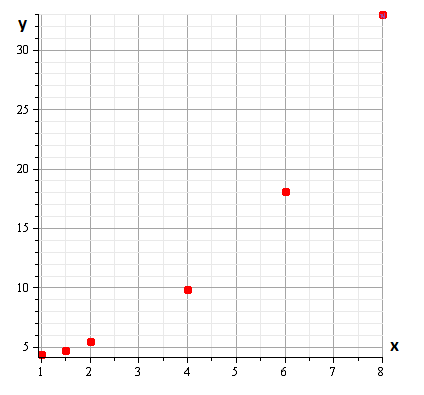
Explanation of Solution
Calculation:
Consider the following data ,
Now draw the scatter plot,
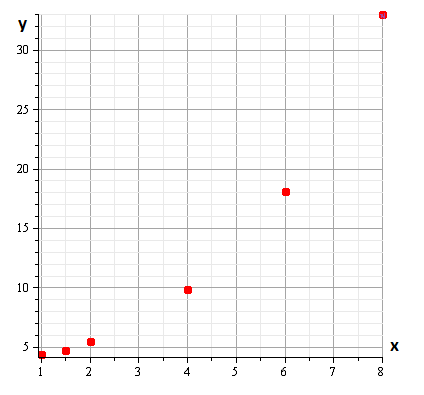
Hence, the scatter plot is drawn.
b.
Verify that the data could best be modelled by a linear model, an exponential model, or a logarithmic model,
b.
Answer to Problem 24PS
Explanation of Solution
Given information:
Decide whether the data could best be modelled by a linear model, an exponential model, or a logarithmic model,
Calculation:
Consider the following data ,
The best model for this data is exponential model.
Hence, the best model is
c.
Explain the model is an exponential model.
c.
Answer to Problem 24PS
Points are growing rapidly,non-linearly.
Explanation of Solution
Calculation:
Consider the following data ,
The best model for this data is exponential model.
It is observed from the graph that points are increasing non-linearly, thus we cannot use a linear model for this condition, it is also that points are growing rapidly thus exponential model is best suited .
Hence, we choose exponential model.
d.
To find the model is an exponential model for the data and graph the model with the scatter plot.
d.
Answer to Problem 24PS
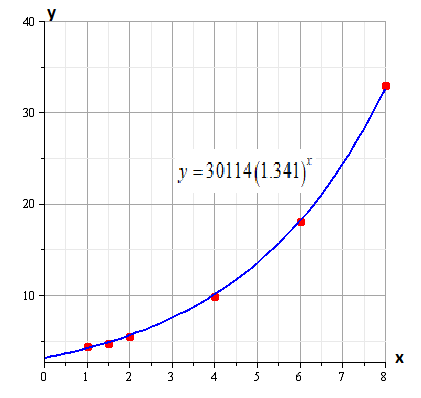
Explanation of Solution
Calculation:
Consider the following data ,
By using the value of
Hence the required model is ,
Now scatter plot for this model,
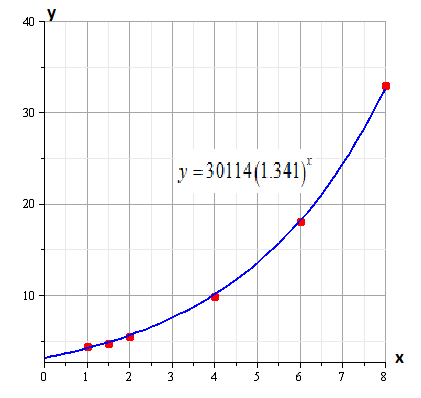
Hence, the required model is
e.
Describe the model you chose fits the data.
e.
Answer to Problem 24PS
Model fits the data.
Explanation of Solution
Calculation:
Consider the required model is ,
Now scatter plot for this model,
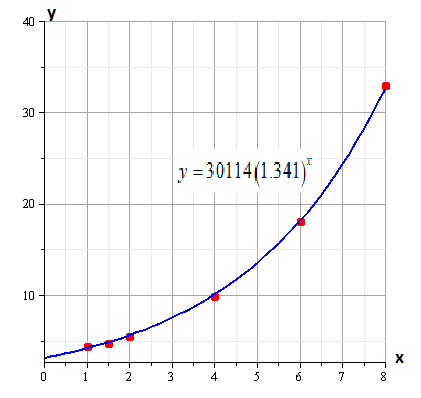
The graph shows model fits the data,
Hence, the model fits the data.
Chapter 3 Solutions
EBK PRECALCULUS W/LIMITS
- Pls help ASAParrow_forward9. a) Determie values of a and b so that the function is continuous. ax - 2b f(x) 2 x≤-2 -2x+a, x ≥2 \-ax² - bx + 1, −2 < x < 2) 9b) Consider f(x): = 2x²+x-3 x-b and determine all the values of b such that f(x) does not have a vertical asymptote. Show work.arrow_forwardPls help ASAParrow_forward
- 3. True False. If false create functions that prove it is false. Note: f(x) = g(x). a) If_lim ƒ(x) = ∞ and_lim g(x) = ∞,then_lim [ƒ(x) − g(x)] = 0 x→ 0+ x→0+ x→0+ b) If h(x) and g(x) are continuous at x = c, and if h(c) > 0 and g(c) = 0, then h(x) lim. will = x→c g(x) c) If lim f(x) = 0 and lim g(x) = 0 then lim f(x) does not exist. x-a x-a x→a g(x)arrow_forwardPls help ASAParrow_forward15. a) Consider f(x) = x-1 3x+2 and use the difference quotient to determine the simplified expression in terms of x, for the slope of any tangent to y = f(x). Also, determine the slope at x = 2. 15 b) Determine the equation of the tangent to f(x) at x = 2. Final answer in Standard Form Ax + By + C = 0, A ≥ 0, with no fractions or decimals.arrow_forward
 Calculus: Early TranscendentalsCalculusISBN:9781285741550Author:James StewartPublisher:Cengage Learning
Calculus: Early TranscendentalsCalculusISBN:9781285741550Author:James StewartPublisher:Cengage Learning Thomas' Calculus (14th Edition)CalculusISBN:9780134438986Author:Joel R. Hass, Christopher E. Heil, Maurice D. WeirPublisher:PEARSON
Thomas' Calculus (14th Edition)CalculusISBN:9780134438986Author:Joel R. Hass, Christopher E. Heil, Maurice D. WeirPublisher:PEARSON Calculus: Early Transcendentals (3rd Edition)CalculusISBN:9780134763644Author:William L. Briggs, Lyle Cochran, Bernard Gillett, Eric SchulzPublisher:PEARSON
Calculus: Early Transcendentals (3rd Edition)CalculusISBN:9780134763644Author:William L. Briggs, Lyle Cochran, Bernard Gillett, Eric SchulzPublisher:PEARSON Calculus: Early TranscendentalsCalculusISBN:9781319050740Author:Jon Rogawski, Colin Adams, Robert FranzosaPublisher:W. H. Freeman
Calculus: Early TranscendentalsCalculusISBN:9781319050740Author:Jon Rogawski, Colin Adams, Robert FranzosaPublisher:W. H. Freeman
 Calculus: Early Transcendental FunctionsCalculusISBN:9781337552516Author:Ron Larson, Bruce H. EdwardsPublisher:Cengage Learning
Calculus: Early Transcendental FunctionsCalculusISBN:9781337552516Author:Ron Larson, Bruce H. EdwardsPublisher:Cengage Learning





